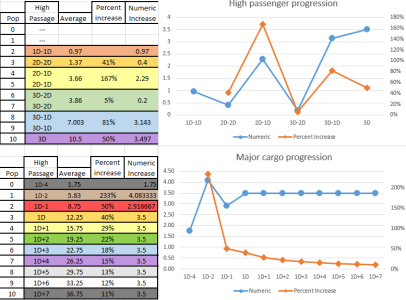I could see there being a "lumpiness" designed into the chart, IF the cargo chart mirrored it. Instead it a fairly smooth progression, much smoother than the passenger chart.

The chart would be far better if you simplified it by
Finding a profitable route for your ship is the easy part, not getting distracted by easy money is the hard part. Last night I looked up a random sector to see how hard it would be to find two POP 5+ world with close TLs, In picked Massilia and found a few good candidates. Among them was this example which is very instructive.
The Shimmer-Damz-Santaw-Virm run would be an excellent location to set up shop. It is not very glamourous, serving only POP 5 worlds. But each one is only 1 TL off the other, and if you stay in the center, Damz - Santaw, you will always have atleast 2 options. But at Santaw there the danger of picking a run to Sempir, because there is a "good" load of cargo. If you take the "good" load of cargo you'll be setting yourself up for a -5 DM on whatever cargo you generate for the return trip, and because it's a POP 4 world the table will be worse than at Santaw.
You could well end up in a similar situation trying to pick the cargo that best fills your hold, Maybe the combination of cargos to Virim leaves you 20 tons short, but the combination to Sempir will fill you completely up. But you're still better off in the long run sticking to he better route.


The chart would be far better if you simplified it by
1) Simplifying the rolls, IE changing 3D-2D or 3D-1D to a modified 2D roll meaning less dice. Note that this does not have a meaningful reduction in complexity the extreme, for 3D-1D 12-17 occurs only 5% of the time. And the average is 7.003 instead of 7. It is the illusion of complexity.
2) Making the chart flow more naturally.
Consider that the very fact of that "unevenness" is not a bug, it's a feature.
It means that the demand for tickets to depart do not rise/fall in a steady (predictable) way. Instead, the demand for insterstellar transport is "lumpy/bumpy" rather than "smooth" as population codes increase.
An analogous way to think of this is that different population codes are at different phases of economic growth waves. Just like with an export business, if you plot growth of exports on a curve over time, that curve is not going to be "smooth" ... instead there's going to be some noise in the results and there are going to be "growth waves" where exports rise and fall as conditions and circumstances change. When there is a major capital investment going on to develop new facilities for new products (for example), exports can potentially fall ... until the new facility center can be brought online and ramped up to full capacity, at which point export potential can "spike" relative to what was happening previously. My point being that growth is not "smooth/linear" but rather "spiky/lumpy" if you plot it on a graph (like you have).
Finding a profitable route for your ship is the easy part, not getting distracted by easy money is the hard part. Last night I looked up a random sector to see how hard it would be to find two POP 5+ world with close TLs, In picked Massilia and found a few good candidates. Among them was this example which is very instructive.
The Shimmer-Damz-Santaw-Virm run would be an excellent location to set up shop. It is not very glamourous, serving only POP 5 worlds. But each one is only 1 TL off the other, and if you stay in the center, Damz - Santaw, you will always have atleast 2 options. But at Santaw there the danger of picking a run to Sempir, because there is a "good" load of cargo. If you take the "good" load of cargo you'll be setting yourself up for a -5 DM on whatever cargo you generate for the return trip, and because it's a POP 4 world the table will be worse than at Santaw.
You could well end up in a similar situation trying to pick the cargo that best fills your hold, Maybe the combination of cargos to Virim leaves you 20 tons short, but the combination to Sempir will fill you completely up. But you're still better off in the long run sticking to he better route.


